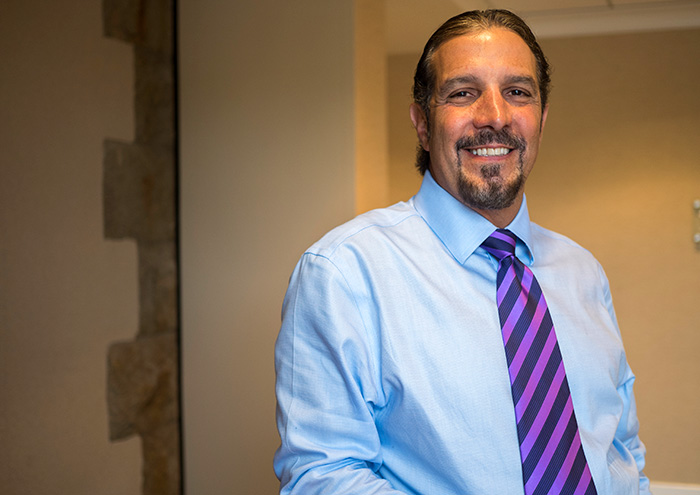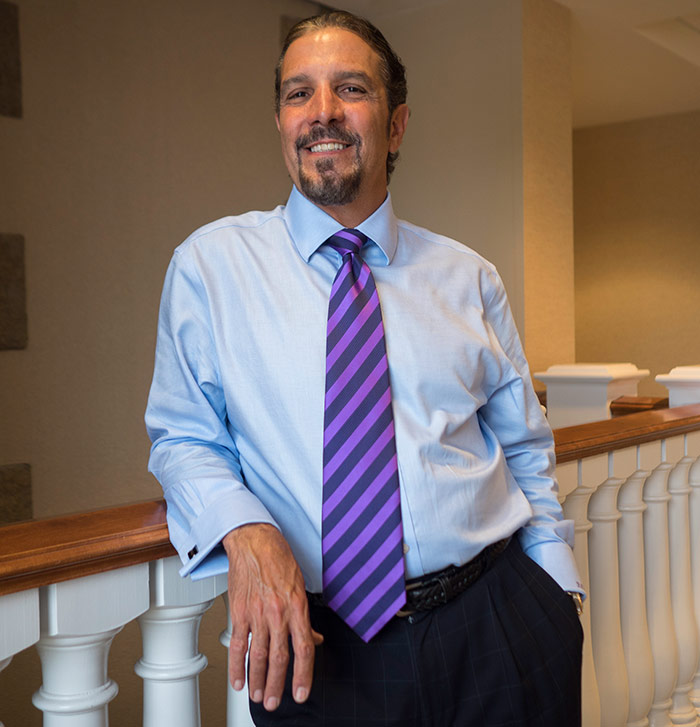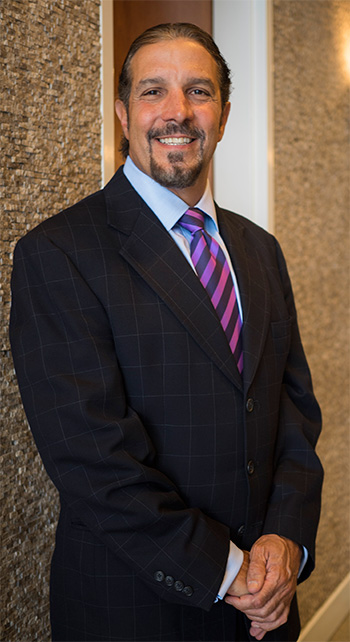Cultivating client trust through comprehensive planning

Robert A. Rebussini, CFS, LUTCF, CSA, CLTC, CRPC • Cranston, RI
Integrated Financial Partners • Lincoln Financial Advisors Corp.
Read full biography below
I was raised in Rhode Island and have lived here my entire life. My parents and brother were all originally from Italy, and they immigrated to the Providence area before I was born. My parents were old school, and it was a great family environment, filled with love and support. I would always bring my college fraternity brothers to our house, unannounced of course, for a big home-cooked Italian meal. My father always broke out the homemade wine.
My father was highly educated in Italy and worked as a professor of Latin and Italian. To make a better life for my family, he came to the United States and initially worked as a dishwasher and in other low-skilled positions until he obtained a job with Prudential, where he worked for 26 years. I personally never had any intentions of working in the financial-services industry; however, I was convinced by my father to at least try it out. I did exactly that almost 30 years ago and have never looked back.

I can handle just about any planning situation for individuals, couples, divorced couples, or business owners, so there really is not a “typical” client. We will work on college funding, business succession planning, pension and 401(k) plans, legacy planning, financial planning, and many other areas clients may need. Our planning approach can cover situations from birth to death and beyond, so we have it well covered!
But our core business gravitates to people who are in their 50s and older, those who are in pre-retirement or already retired. These individuals are concerned. They want to know, “Do I have enough money? Is it in the right place? Which should I use first?”
“My overall goal is to deliver a plan that allows people to sleep at night. That means smoothing out the effects of market volatility and having more consistent returns over time.”
We have a formal and proprietary planning model called the Lifetime Income Model. This model has several specific steps that lead through a very disciplined planning process. Before I go into detail on that, I want to emphasize two important points about the way I work with clients.
First, I want to get to know each and every client on a personal basis as best I can. I ask about a lot of the intangible factors that help define their attitudes toward family, money, and their future. What is in their heart? How do the relationships work in their life? What are their dreams for the future? I also ask what is on their “bucket list.” This helps me to build a suitable plan that drives overall decision-making and investment scenarios.
Second, our firm strongly believes in working hand in hand with clients’ other trusted advisors. These are most often their CPA and attorney, but it could extend beyond that core. The idea of having the three key advisors—financial planner, CPA, and attorney—all working together to find prudent solutions for people takes a great deal of work, but is well worth it. I directly ask clients, “When was the last time you had all of your advisors speaking to one another?” The answer is usually “never.” We want to make sure issues like having assets properly titled or utilizing tax-advantaged strategies are in sync with what each of the three advisors is doing. Otherwise it is like buying a sophisticated new car and never putting any gas in it. It simply will not run.
The Lifetime Income Model helps us lay out a path to lifetime income based on realistic retirement distributions. It is based around how a client’s personal situation influences the investment strategy. A client’s age, specific needs, goals, and risk tolerance determine the amount of assets, their allocation mix, and the time horizon for holding them. Two core principles are what we call the “necessary estate” and the “excess estate.” The necessary estate represents the assets needed to help fund lifetime income. The excess estate is what is left beyond that, and what can be used for legacy or charitable planning.

The model helps us pull all of this information together in a systematic fashion, and essentially we create a number of buckets of assets that will cover a client’s income needs throughout the rest of their life. These are generally in five-year time frames. For example, the first bucket of assets covering the first five years of income distribution will be very liquid or in guaranteed products, with little or no exposure to investment risk. This way a client will know that combining all of their income sources for that first five years will provide them with an adequate and dependable paycheck.
We then move out to subsequent five-year buckets, with the ability to increase risk exposure along the way. One of the benefits of this approach is being able to reassure clients during particularly rough market periods. In most cases, I can tell clients that even if the market overall is going down, the assets that are exposed to that risk do not have to be touched for at least 10 years. In many cases, those assets are in risk-managed strategies. We can have a fairly high level of confidence that those assets will be able to rebound in value over that 10-year holding period.
 I tell clients that retirement is like mountain climbing. Most experienced climbers do not get into trouble during the ascent; they often find that the descent is more difficult and problematic. They might be tired, or haven’t planned it out the way they did the climb, or they simply run into unforeseen obstacles. Same thing with retirement planning. People have not fully considered the risks associated with managing an income stream in retirement and how they deploy their assets. That is where we can help out as their guide. Time and risk management become extremely important during the distribution phase.
I tell clients that retirement is like mountain climbing. Most experienced climbers do not get into trouble during the ascent; they often find that the descent is more difficult and problematic. They might be tired, or haven’t planned it out the way they did the climb, or they simply run into unforeseen obstacles. Same thing with retirement planning. People have not fully considered the risks associated with managing an income stream in retirement and how they deploy their assets. That is where we can help out as their guide. Time and risk management become extremely important during the distribution phase.
We manage risk in several ways: through the Lifetime Income Model and the concept of time- and asset-based planning, and by paying careful attention to asset-allocation models, which dictate the bulk of a client’s returns over time. For risk assets, we will frequently use the services of third-party asset managers who take a proactive and risk-managed approach to portfolio strategies.
Finally, we have a wide choice of asset classes, products, or strategies we can use. Along with the universe of traditional investments, we could include active return strategies, an absolute-return strategy, alternative-investment strategies, or guaranteed-annuity strategies. The overall net result of this is that not every bucket or every strategy has to fire away continuously on all cylinders. If one aspect within the plan underperforms, we think we have built in enough diversification and safeguards to preserve the integrity of the overall plan.
My overall goal is to deliver a plan that allows people to sleep at night. That means smoothing out the effects of market volatility and having more consistent returns over time. The returns of the S&P 500 are important, but not as a benchmark for our clients. Their benchmark is what is going to deliver on their specific goals and needs. I believe in taking no more risk than is necessary. That has become the hallmark of our practice and a method of planning that our clients have found very appropriate.
 Robert Rebussini has worked in financial services for close to three decades. His practice focuses on providing individuals, executives, and business owners with strategic solutions for their estate, business, and financial planning needs. His personal philosophy is to “keep clients current on the latest strategies for producing reliable retirement income, minimizing estate taxes, and structuring investment portfolios based on goals and time horizons.”
Robert Rebussini has worked in financial services for close to three decades. His practice focuses on providing individuals, executives, and business owners with strategic solutions for their estate, business, and financial planning needs. His personal philosophy is to “keep clients current on the latest strategies for producing reliable retirement income, minimizing estate taxes, and structuring investment portfolios based on goals and time horizons.”
Mr. Rebussini’s expertise in retirement and investment planning is a result of his dedication to continuing education. This includes earning the Chartered Retirement Planning Counselor (CRPC) designation and the Certified in Long-Term Care (CLTC) designation. Mr. Rebussini is a graduate of the University of Rhode Island, where he studied business administration and marketing.
A frequent speaker at workshops and seminars, Mr. Rebussini has received a National Leadership Award from the majority leader of the U.S. House of Representatives. This recognition includes an invitation to contribute to the Business Advisory Board on such issues as tax packages and strategies. Mr. Rebussini has also served on the Pension and Retirement Board of Johnston, Rhode Island. He has been listed numerous times in Rhode Island Monthly Magazine as a “Five Star Wealth Manager.”
Mr. Rebussini and his wife, Carol, live in Johnston with their two children. In his spare time, he enjoys keeping fit, studying martial arts, skiing, and golf. He is also an avid maker and collector of fine wines. Mr. Rebussini has mentored children for several years with the Rhode Island Mentoring Program. He is also involved in charitable and volunteer outreach with several organizations working with disadvantaged and at-risk community members.
Disclosure: Robert Rebussini is a registered representative of Lincoln Financial Advisors Corp. Securities and investment advisory services offered through Lincoln Financial Advisors Corp., a broker-dealer and registered investment advisor. Insurance offered through Lincoln affiliates and other fine companies. It is not our position to offer legal or tax advice. Integrated Financial Partners Inc. is not an affiliate of Lincoln Financial Advisors Corp. CRN-1532884-062416
Photography by Mae Gammino

